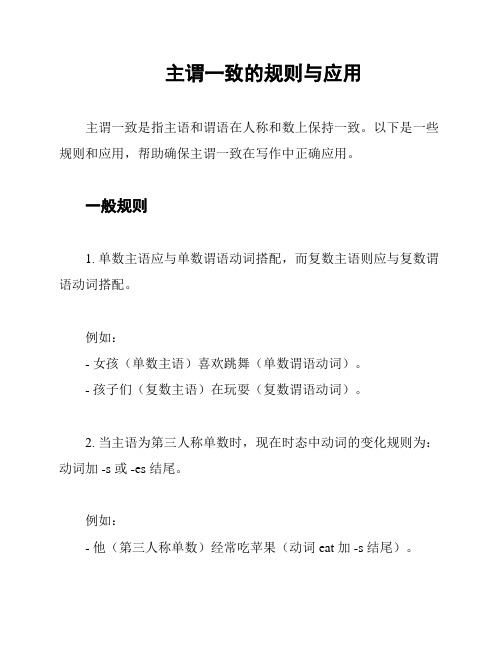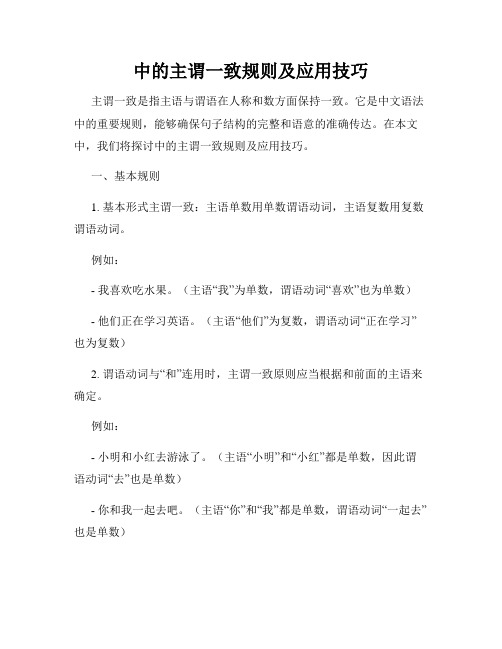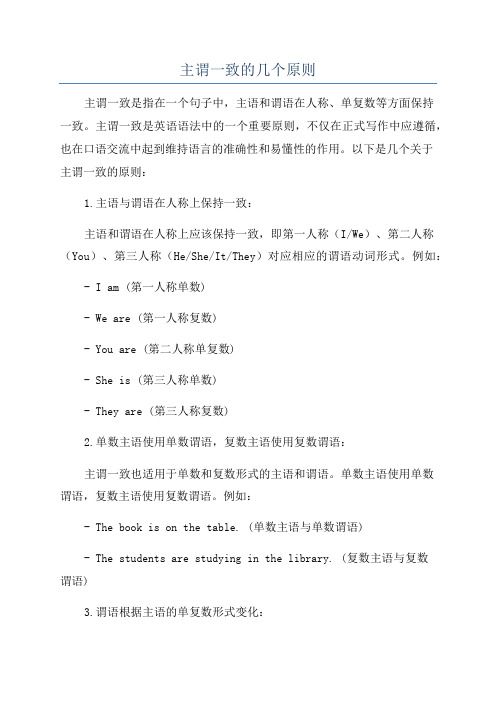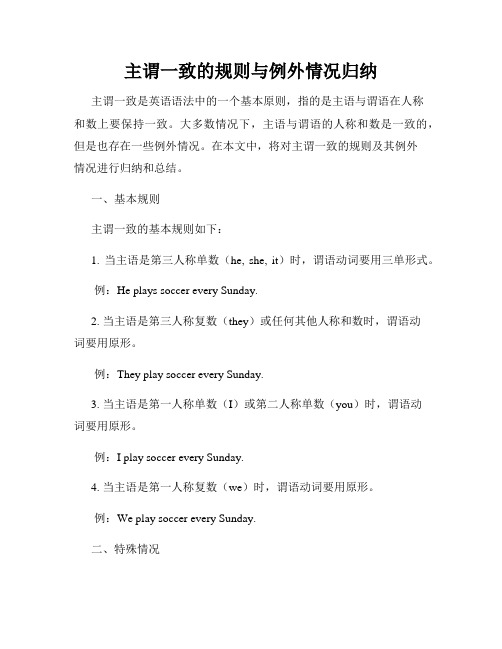关于主谓一致的用法规律
主谓一致的规则与应用

主谓一致的规则与应用主谓一致是指主语和谓语在人称和数上保持一致。
以下是一些规则和应用,帮助确保主谓一致在写作中正确应用。
一般规则1. 单数主语应与单数谓语动词搭配,而复数主语则应与复数谓语动词搭配。
例如:- 女孩(单数主语)喜欢跳舞(单数谓语动词)。
- 孩子们(复数主语)在玩耍(复数谓语动词)。
2. 当主语为第三人称单数时,现在时态中动词的变化规则为:动词加 -s 或 -es 结尾。
例如:- 他(第三人称单数)经常吃苹果(动词 eat 加 -s 结尾)。
3. 主谓一致也适用于过去时态。
例如:- 小狗(单数主语)跑了(过去时谓语动词)。
特殊情况1. 当主谓之间有连词和或者或时,谓语动词的单复数形式应根据连词前的主语来确定。
例如:- 马克或者凯特(复合主语)每天写作业(单数谓语动词)。
2. 当主语由两个或多个名词短语组成时,谓语动词的单复数形式应与离它最近的名词短语保持一致。
例如:- 咖啡和茶(复合主语)是她喜欢的饮品(复数谓语动词)。
3. 当主语由一个集合名词构成时,谓语动词的单复数形式取决于集合名词是否指一个整体还是其中的成员个体。
例如:- 代表团(集合名词)正在讨论(单数谓语动词)。
个别情况1. 当主语为复数名词,但表示一个整体时,谓语动词可与单数或复数搭配。
例如:- 四季(复数名词)是很美的(单数谓语动词)/ 四季(复数名词)都是很美的(复数谓语动词)。
2. 当主语为复数名词,但表示某种集合时,谓语动词通常与复数搭配。
例如:- 孩子们(复数名词)喜欢糖果(复数谓语动词)。
结论主谓一致是写作中一个重要的语法规则。
正确应用主谓一致有助于使句子更加清晰和易于理解。
根据不同的情况,采用上述规则和应用来确保主谓一致在语言表达中正确运用。
中的主谓一致规则及应用技巧

中的主谓一致规则及应用技巧主谓一致是指主语与谓语在人称和数方面保持一致。
它是中文语法中的重要规则,能够确保句子结构的完整和语意的准确传达。
在本文中,我们将探讨中的主谓一致规则及应用技巧。
一、基本规则1. 基本形式主谓一致:主语单数用单数谓语动词,主语复数用复数谓语动词。
例如:- 我喜欢吃水果。
(主语“我”为单数,谓语动词“喜欢”也为单数)- 他们正在学习英语。
(主语“他们”为复数,谓语动词“正在学习”也为复数)2. 谓语动词与“和”连用时,主谓一致原则应当根据和前面的主语来确定。
例如:- 小明和小红去游泳了。
(主语“小明”和“小红”都是单数,因此谓语动词“去”也是单数)- 你和我一起去吧。
(主语“你”和“我”都是单数,谓语动词“一起去”也是单数)3. 当主语由两个或多个单数名词或代词以“与”、“跟”、“和”等连接时,谓语动词的数与最近的名词或代词保持一致。
例如:- 你们和他来了。
(主语“你们”和“他”,“他”是单数,因此谓语动词“来了”也是单数)- 我和她买了很多衣服。
(主语“我”和“她”,“她”是单数,因此谓语动词“买了”也是单数)二、特殊情况及解决方法有些情况下,我们需要注意特殊的主谓一致规则,特别是当主语包含有数量词、集体名词和不定代词时。
1. 主语包含数量词时,谓语动词的单复数与数量词后面的名词保持一致。
例如:- 五个小朋友在玩耍。
(数量词“五个”后面的名词“小朋友”是复数,因此谓语动词“在玩耍”也是复数)- 一本书在桌上。
(数量词“一本”后面的名词“书”是单数,谓语动词“在”是单数)2. 主语是集体名词时,谓语动词的单复数根据语意来确定。
例如:- 一家人正在看电视。
(虽然“一家人”是集体名词,但看电视的动作是每个人在做,因此谓语动词“正在看”是复数)- 这个队伍的成员正在训练。
(虽然“队伍”是集体名词,但成员分别在训练,因此谓语动词“正在训练”是复数)3. 主语是不定代词时,谓语动词通过与不定代词的意义来确定。
主谓一致的几个原则

主谓一致的几个原则主谓一致是指在一个句子中,主语和谓语在人称、单复数等方面保持一致。
主谓一致是英语语法中的一个重要原则,不仅在正式写作中应遵循,也在口语交流中起到维持语言的准确性和易懂性的作用。
以下是几个关于主谓一致的原则:1.主语与谓语在人称上保持一致:主语和谓语在人称上应该保持一致,即第一人称(I/We)、第二人称(You)、第三人称(He/She/It/They)对应相应的谓语动词形式。
例如:- I am (第一人称单数)- We are (第一人称复数)- You are (第二人称单复数)- She is (第三人称单数)- They are (第三人称复数)2.单数主语使用单数谓语,复数主语使用复数谓语:主谓一致也适用于单数和复数形式的主语和谓语。
单数主语使用单数谓语,复数主语使用复数谓语。
例如:- The book is on the table. (单数主语与单数谓语)- The students are studying in the library. (复数主语与复数谓语)3.谓语根据主语的单复数形式变化:谓语动词的形式会根据主语的单复数形式而发生变化。
一般情况下,复数主语使用谓语动词的原形,而单数主语使用谓语动词的第三人称单数形式。
例如:- The dog barks. (单数主语使用第三人称单数动词形式)- The dogs bark. (复数主语使用动词原形)4.不定代词与谓语要保持一致:在使用不定代词作为主语时,谓语动词的形式要与不定代词的数保持一致。
例如:- Somebody has left their bag. (不定代词somebody与谓语动词has保持一致)5.基于语法结构的主谓一致:有些复杂的语法结构,在主谓一致上需要更多的注意。
例如:- 以either...or...、neither...nor...、not only...but also...连接两个主语时,谓语动词的形式要与靠近的主语保持一致,例如:- Either John or his friends are going to the party. (谓语动词与靠近的主语friends保持一致)- Neither the teacher nor the students were present. (谓语动词与靠近的主语students保持一致)- 当主语由as well as、along with、together with等短语结构引出时,谓语动词的形式要与前面的主语保持一致- The book, as well as the pen, is on the table. (谓语动词与前面的主语book保持一致)- 当主语由there is/are开头时,谓语动词的形式要与后面的主语保持一致,例如:- There is a book on the table. (谓语动词与后面的主语book保持一致)- 当主语由a number of、a majority of、the majority of等短语开头时,谓语动词的形式要与后面的名词保持一致,例如:总之,主谓一致是英语语法中的重要原则,人们在使用英语时应该根据主语的单复数形式、人称以及语法结构等因素,正确选择与之相对应的谓语动词形式。
主谓一致的规则与例外情况归纳

主谓一致的规则与例外情况归纳主谓一致是英语语法中的一个基本原则,指的是主语与谓语在人称和数上要保持一致。
大多数情况下,主语与谓语的人称和数是一致的,但是也存在一些例外情况。
在本文中,将对主谓一致的规则及其例外情况进行归纳和总结。
一、基本规则主谓一致的基本规则如下:1. 当主语是第三人称单数(he, she, it)时,谓语动词要用三单形式。
例:He plays soccer every Sunday.2. 当主语是第三人称复数(they)或任何其他人称和数时,谓语动词要用原形。
例:They play soccer every Sunday.3. 当主语是第一人称单数(I)或第二人称单数(you)时,谓语动词要用原形。
例:I play soccer every Sunday.4. 当主语是第一人称复数(we)时,谓语动词要用原形。
例:We play soccer every Sunday.二、特殊情况除了上述基本规则外,还存在一些特殊情况,需要注意主谓一致的变化。
1. 不定代词“everyone, everybody, someone, somebody”等作主语时,谓语动词要用单数形式。
例:Everybody knows the answer to this question.2. 当主语由“each, either, neither”修饰时,谓语动词也要用单数形式。
例:Each of the boys has his own book.3. 当主语是复数名词,但表示一个整体时,谓语动词要用单数形式。
例:The team is practicing for the upcoming game.4. 某些以复数形式出现的名词,但作为单一实体看待时,谓语动词要用单数形式。
例:Physics is my favorite subject.5. 当主语是由“more than one, most of, a lot of, a number of”等引导的复数词组时,谓语动词要用复数形式。
主谓一致的基本规则

主谓一致的基本规则主谓一致是语法中的重要原则,指的是主语与谓语在人称、数和时态上要保持一致。
主谓一致的正确运用可以有效避免语法错误,使句子更加准确、通顺。
下面将介绍主谓一致的基本规则。
一、基本规则1. 一般情况下,主谓在人称、数上要保持一致。
当主语为第三人称单数时,谓语动词要用单数形式;主语为第一人称或第二人称,或者为复数时,谓语动词要用复数形式。
例如:- He likes to play basketball.(他喜欢打篮球。
)- We are going to the beach tomorrow.(我们明天要去海滩。
)- They enjoy watching movies.(他们喜欢看电影。
)2. 当主语为连接词或短语时,要根据连接词前的部分来决定谓语动词的数。
例如:- Bread and butter is my favorite breakfast.(面包和黄油是我最喜欢的早餐。
)- Apples, oranges, and grapes are my favorite fruits.(苹果、橘子和葡萄是我最喜欢的水果。
)3. 当主语为不可数名词时,谓语动词要用单数形式。
例如:- Music brings joy to people's hearts.(音乐给人们带来快乐。
)- Water is essential for life.(水对生命至关重要。
)4. 当主语为复数名词,但表示一个整体或团体时,谓语动词要用单数形式。
例如:- The class is going on a field trip.(全班同学要去郊游。
)- The committee makes the final decision.(委员会做出最终决策。
)5. 当主语为复数名词,表示个体时,谓语动词要用复数形式。
例如:- The boys are playing soccer in the park.(男孩们在公园里踢足球。
主谓一致的用法与例句解析

主谓一致的用法与例句解析主谓一致是英语语法中非常重要的一个概念,指的是主语和谓语在人称和数上要保持一致。
主谓一致的正确运用可以使句子更加准确、清晰和易于理解。
本文将介绍主谓一致的用法,并通过例句解析来帮助读者更好地理解和掌握。
一、基本规则1. 单数主语与单数谓语动词一致,复数主语与复数谓语动词一致:- The cat eats fish.(猫吃鱼。
)- The boys play football.(男孩们踢足球。
)2. 不可数名词作主语时,谓语动词用单数形式:- Water is essential for life.(水对生命是必不可少的。
)- This news is very shocking.(这个消息非常震惊。
)3. 用and连接的两个或多个主语,如果表示同一事物或同一人,则谓语动词用单数形式;如果表示不同事物或不同人,则谓语动词用复数形式:- Bread and butter is his favorite breakfast.(面包和黄油是他最喜欢的早餐。
)- Tom and Jack are good friends.(汤姆和杰克是好朋友。
)4. 以every, each, either, neither等为主语的句子,谓语动词用单数形式:- Every child needs love and care.(每个孩子都需要爱和关心。
)- Neither of them is available tomorrow.(他们俩明天都不可用。
)二、特殊情况1. 多个名词作主语,其中有一个是表示数量或距离的词时,谓语动词根据量词或距离词的数来决定单复数:- Five kilometers is a long way to walk.(五公里是一个很长的路程。
)- Three cups of coffee are enough for me.(对我来说,三杯咖啡就足够了。
)2. 在There be句型中,谓语动词的单复数与后面的主语一致:- There is a book on the table.(桌子上有一本书。
主谓一致语法总结
主谓一致语法总结主谓一致是指中文句子中的主语与谓语在人称和数上保持一致的语法规则。
即当主语为单数时,谓语动词要用单数形式;当主语为复数时,谓语动词要用复数形式。
主谓一致是语言表达准确性和语法规范性的重要组成部分,能够帮助读者或听者更好地理解句子的意思。
下面对主谓一致语法进行详细总结。
一、主谓一致的基本规则1. 主谓一致的人称与数主谓一致在人称上要求主语和谓语动词在人称上保持一致。
一般来说,第一人称(I、we)、第二人称(you)和第三人称(he、she、it、they)的主语分别对应特定的谓语动词形式,要根据不同人称选择正确的动词形式。
例句1:I am a teacher.(我是一名教师。
)第一人称单数主语 "I"对应第一人称单数谓语动词 "am"。
例句2:They are students.(他们是学生。
)第三人称复数主语 "they"对应第三人称复数谓语动词 "are"。
2. 单数主谓一致单数主语要与单数谓语动词保持一致。
单数主语可以是单个名词、不可数名词或单数名词短语。
例句3:The cat is sleeping.(那只猫正在睡觉。
)单数主语 "the cat"对应单数谓语动词 "is"。
例句4:Mathematics is my favorite subject.(数学是我最喜欢的科目。
)单数主语 "Mathematics"对应单数谓语动词 "is"。
3. 复数主谓一致复数主语要与复数谓语动词保持一致。
复数主语可以是由两个或更多名词组成的名词短语,或者是复数名词。
例句5:The books are on the shelf.(书在书架上。
)复数主语 "The books"对应复数谓语动词 "are"。
主谓一致语法总结
主谓一致语法总结主谓一致语法是指句中主语与谓语在人称和数方面保持一致。
主谓一致语法在英语中是十分重要的一个语法规则。
正确的使用主谓一致可以使句子更加流畅和准确。
下面是关于主谓一致语法的总结。
一、基本原则1. 主谓一致是指主语与谓语在人称和数量方面保持一致。
2. 当主语是第三人称单数时,谓语动词要加-s、-es、-ies 或动词的其他变化形式。
3. 当主语是第一、第二人称、复数或不可数名词时,谓语动词不加-s、-es、-ies。
二、人称一致1. 当主语是第三人称单数时,谓语动词要加-s、-es、-ies。
例:He plays tennis every day.(他每天打网球。
)2. 当主语是第一、第二人称,复数或不可数名词时,谓语动词不加-s、-es、-ies。
例:We go to school together.(我们一起上学。
)三、数量一致1. 当主语为可数名词并为复数时,谓语动词不加-s、-es、-ies。
例:The students study hard.(学生们学习刻苦。
)2. 当主语为可数名词但为单数时,谓语动词要加-s、-es、-ies。
例:The cat sleeps on the couch.(猫睡在沙发上。
)3. 当主语为不可数名词时,谓语动词不加-s、-es、-ies。
例:The water tastes good.(水味道不错。
)四、特殊情况1. 当主语为复数名词但表示整体或团体时,谓语动词要用单数形式。
例:The team is playing well.(球队表现不错。
)2. 当主语为两个或两个以上的名词并由and连接时,谓语动词要用复数形式。
例:Tom and Jerry are good friends.(汤姆和杰瑞是好朋友。
)3. 当主语由either...or,neither...nor,not only...but also等连接时,谓语动词的单复数要根据最靠近的名词来确定。
主谓一致的用法详解
主谓一致的用法详解主谓一致是英语语法中的一个重要概念,它要求主语和谓语在人称和数上保持一致。
正确运用主谓一致规则不仅可以使句子表达准确,还可以提升整体语言的流畅性和规范性。
本文将详细介绍主谓一致的用法及相关注意事项。
一、基本规则1. 单数主语对应单数谓语动词:例子:The cat sleeps on the sofa.(猫在沙发上睡觉。
)2. 复数主语对应复数谓语动词:例子:The dogs bark loudly.(狗在大声叫。
)3. 不可数名词作主语时,谓语动词通常用单数形式:例子:Time flies.(时间飞逝。
)二、特殊情况及注意事项1. 复合主语当主语由两个或更多名词组成,并由and连接时,谓语动词通常用复数形式:例子:Tom and Jerry are good friends.(汤姆和杰瑞是好朋友。
)2. 不定代词的用法a) 当不定代词everyone,everyone,either,neither或many a以及由some,any,no等词构成的不定代词做主语时,谓语动词用单数形式:例子:Everyone has their own dreams.(每个人都有自己的梦想。
)b) 当不定代词some,many或both作主语时,谓语动词的单复数形式根据其后的名词决定:例子:Some of the students are going on a field trip.(一些学生将进行实地考察。
)3. 存在复数主语的情况a) 当两个或多个单数主语被连接词and连接时,谓语动词用复数形式:例子:Bread and butter are my breakfast.(面包和黄油是我的早餐。
)b) 当两个或多个单数主语由or或nor连接时,谓语动词与最近的主语保持一致:例子:Neither the cat nor the dog likes milk.(猫和狗都不喜欢牛奶。
)4. 存在特殊句型的情况a) 当主语是以“The only one of...”或“One of...”开头的句子时,谓语动词的单复数形式取决于其后的名词:例子:One of my friends is coming to visit me.(我的一个朋友要来看我。
高中英语知识点归纳主谓一致
高中英语知识点归纳主谓一致高中英语知识点归纳-主谓一致主谓一致是英语语法中重要的一部分,它要求句子中的主语和谓语在人称和数上保持一致。
在语言表达中,确保主谓一致可以使句子更加准确清晰,避免产生歧义。
以下是一些主谓一致的常见情况和规则。
一、基本规则1. 主谓一致的基本规则是当主语是单数时,谓语动词用单数形式;主语是复数时,谓语动词用复数形式。
例如:She runs every morning.(她每天早晨跑步。
)They go to school together.(他们一起去学校。
)2. 当主语是第三人称单数,谓语动词用单数形式。
而当主语是第一人称、第二人称或复数形式,谓语动词用复数形式。
例如:He speaks English fluently.(他流利地讲英语。
)We play soccer every Saturday.(我们每个星期六踢足球。
)二、特殊情况和规则1. 使用句型“There is/are”时,主谓一致取决于关系代词的数。
例如:There is a book on the table.(桌子上有一本书。
)There are some applesin the basket.(篮子里有几个苹果。
)2. 使用分数作主语时,谓语动词用单数形式。
例如:One third ofthe class is absent today.(这个班级有三分之一的人今天缺席。
)3. 当主语由“each”、“every”、“no”、“either”、“neither”等引导时,谓语动词常用单数形式。
例如:Each student has a textbook.(每个学生都有一本教科书。
)Neither of them is interested in sports.(他们中没有一个对运动感兴趣。
)4. 连系动词(如be动词、appear、seem等)后的表语通常与主语保持一致。
例如:The book is interesting.(这本书很有趣。
- 1、下载文档前请自行甄别文档内容的完整性,平台不提供额外的编辑、内容补充、找答案等附加服务。
- 2、"仅部分预览"的文档,不可在线预览部分如存在完整性等问题,可反馈申请退款(可完整预览的文档不适用该条件!)。
- 3、如文档侵犯您的权益,请联系客服反馈,我们会尽快为您处理(人工客服工作时间:9:00-18:30)。
关于主谓一致的用法规律
惠阳三中刘沁姗
在备战中考英语阶段,我认为主谓一致这一用法规律非常重要,值得进行好好的归纳总结。
而且学生也掌握的并不好,由此我通过结合初三复习资料—南方新课堂(中考风向标)得出以下用法规律。
一、最基本却贯穿英语知识的学习,当以单数名词或代词、动词不
定式短语作主语时,谓语动词用单数;主语为复数时,谓语用复数。
在这里举一个“动词不定式短语作主语”的例子:To see is to believe. 简单但却结构特别的例子最容易让学生记住和接受。
二、由and或both and 连接的并列成分作主语时,谓语动词用复
数。
但并列主语如果指的是同一个人、同一事物或同一概念,谓语动词用单数。
在此,先看两个例子:1、The poet and writer has come. 2、The poet and the writer have come. 通过对比这两个例子可以得出:第一个例句的主语指的是同一个人,第二句则指的是两个不同的人,所以主语的单复数决定了谓语的不同。
三、由and连接的并列单数主语之前如果分别由each, every, no修
饰时,其谓语动词要用单数形式。
例如:In our country every boy and every girl has the right to receive education.在此再给另一个例子进行对比:Now the students each have an English-Chinese dictionary.
这个例子真正的主语是the students,所以谓语用复数。
四、主语时单数时,尽管后面跟有but, except, besides, with, as well
as, together with, along with, like等引导的介词短语时,谓语动词与前面的主语一致。
这个就是常用的“就远原则”。
例如:He, together with his parents, is going to visit Shanghai.句子的主语是he,所以谓语动词用单数。
五、一些只有复数形式的名词,如people, police, cattle, clothes等作
主语时,谓语动词用复数。
如:1、Common people like to see light-hearted movies. 2、The police report that the criminal is on the run.
六、集体名词family, class, team, group等看作整体时,谓语动词用
单数,看作每一个成员时,谓语动词用复数。
如:1、The class wins the prize. 2、The class are all carefully reading books. 例1的主语指的是整个班集体,例2指的是班上的学生,故使用相对应的谓语。
七、当表示国家,城市,人名,书名,报纸,杂志及组织机构等专
有名词做主语时,作为整体,谓语动词用单数形式。
八、News, math, physics, politics等词貌似复数,实为单数,做主语
时,其谓语动词用单数。
如:Physics is more difficult than
Chinese.
九、the+形容词,如the poor, the rich, the young, the old, the dead, the
sick, the brave等做主语时表示一类人,谓语动词用复数。
十、由each, some, any, no, every构成的复合代词做主语时,谓语动
词用单数。
如:Each of the girls here has been to the West Lake twice.
十一、有两部分构成的物体的名词,如glasses, shoes, trousers, chopsticks, scissors等作主语时,谓语动词用复数。
但如果这类名词前用了a pair of等,则谓语动词的单复数形式往往取决于pair 的单复数形式。
如:This pair of trousers belongs to Tom.
十二、表示时间,距离,价格,度量衡等的名词作主语时,谓语动词通常用单数。
十三、不定代词由all, most, more, some, any, none作主语时,也要依这些代词表示的意义来决定谓语动词的单复数形式。
如果代词代表单数可数名词或不可数名词,谓语动词用单数;如果代词代表复数可数名词,谓语动词用复数。
在此,结合另一种情况进行对比区分:由不定代词either, neither, each, one, everyone, someone, anyone, no one, something, anything, everything, something, anything,
nothing, everything等做主语或修饰主语时,谓语动词通常用单数。
如:Everybody is here.
十四、疑问代词作主语时,其谓语动词也有两种情况:主语表示复数意义,谓语动词用复数;主语表示单数意义,则谓语动词用单数。
十五、分数(百分数)+ of +名词作主语时,谓语动词的单复数取决于of 后面的名词的数。
但要注意population一词,用作整体时,谓语动词用单数,用其部分做主语时,谓语动词形式用复数。
如:
1、The population is growing faster and faster.
2、50% of the
population are tested by the program.
十六、Half, the rest等表示不定数量的名词作主语时,如果所指为复数意义,动词用复数;如果所指为单数意义,动词用单数。
如:
1、Half of the water is becoming blue.
2、The rest of the people are
going there by bus.
十七、由what引出的从句作主语时,通常谓语动词用单数形式。
但如果所指内容为复数意义时,谓语动词用复数形式。
十八、由连词not···but, or, either···or, neither···nor, not
only··· but also等连接的并列主语,如果一个是单数,一个是复数,则谓语动词按就近一致原则,与最靠近它的主语一致。
如:1、Neither Tony nor Frank likes the CD. 2、Either Tony or my two brothers like the CD.
十九、There be句型、以here开头的句子,谓语动词和靠近的主语一致。
如:1、There is some water and some seeds in the bottle. 2、Here are my two socks and one hat.
二十、 A number of 后面加复数名词或代词,其动词用复数形式;
但the number of后面加复数名词或代词时,其谓语用单数。
如:The number of people invited was fifty, but a number of them were absent for different reasons.
二十一、One or two+复数名词做主语时,谓语动词用复数。
如:One or two boys are missed.
二十二、Many a+单数名词(意为许多),more than one+单数名词(不止一···)做主语时,尽管意思是复数,但谓语动词还是用单数。
如:Many a bird was gone. 然而more than+基数词+复数名词的结构或more+复数名词+than one作主语时,谓语用单数。
如:More trees than one were cut.
二十三、This kind of book=a book of this kind(这种书)作主语时,谓语动词用单数;this kind of men=men of this kind=these kind of men(这类人,口语中用),this kind of men的谓语用单数,men of this kind=these kind of men的谓语用复数。
All kinds of后跟复数名词,谓语用复数。
以上就是我通过相关的习题总结出的主谓一致用法规律,在此还有首帮助学习的记忆口诀:集体名词作主语,重全体时谓用单,如若强调其成员,复数谓语记心间。
有些名词谓常复,people、police即这般。
单数主语接介短,谓语单数介无关,many a做主也如此,复数意思谓却单。
Or, nor, but also, there be,近主原则挂嘴边。
